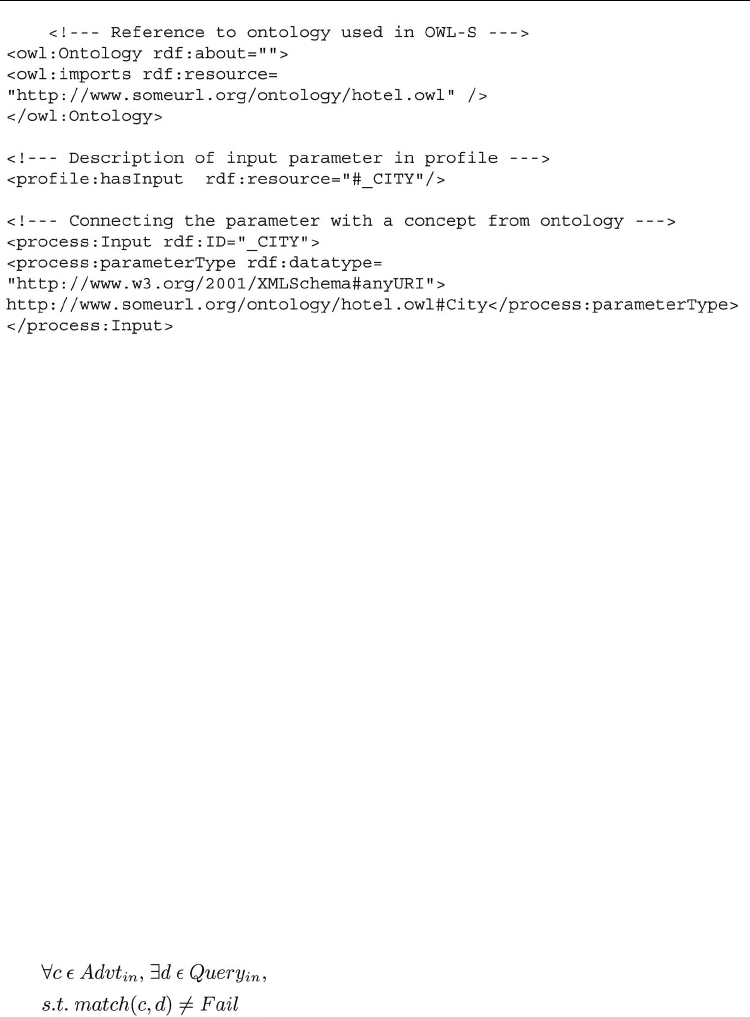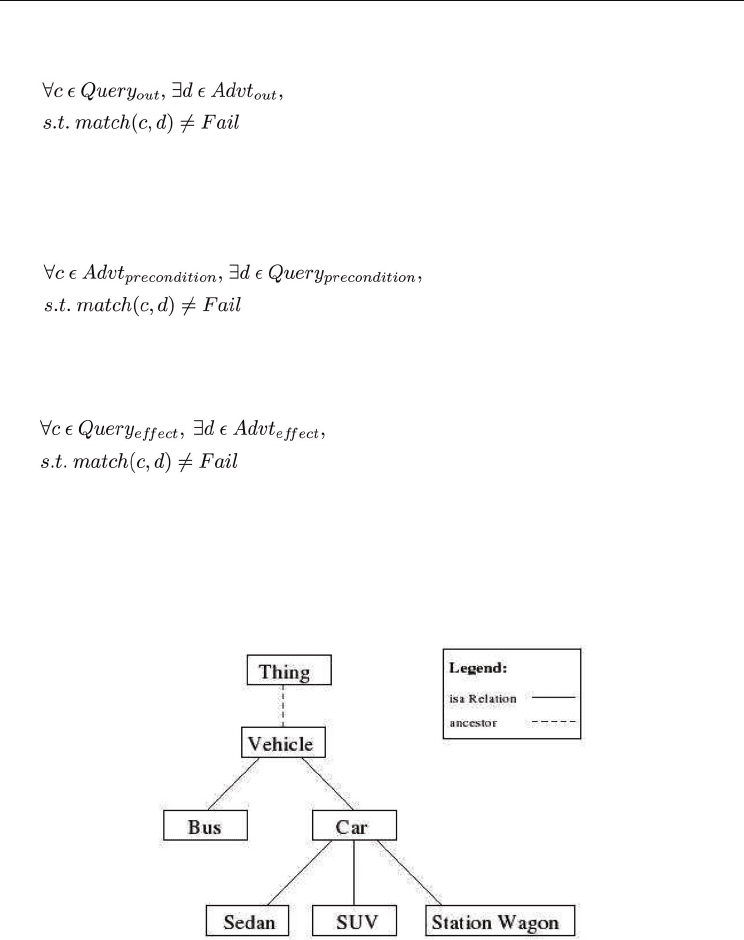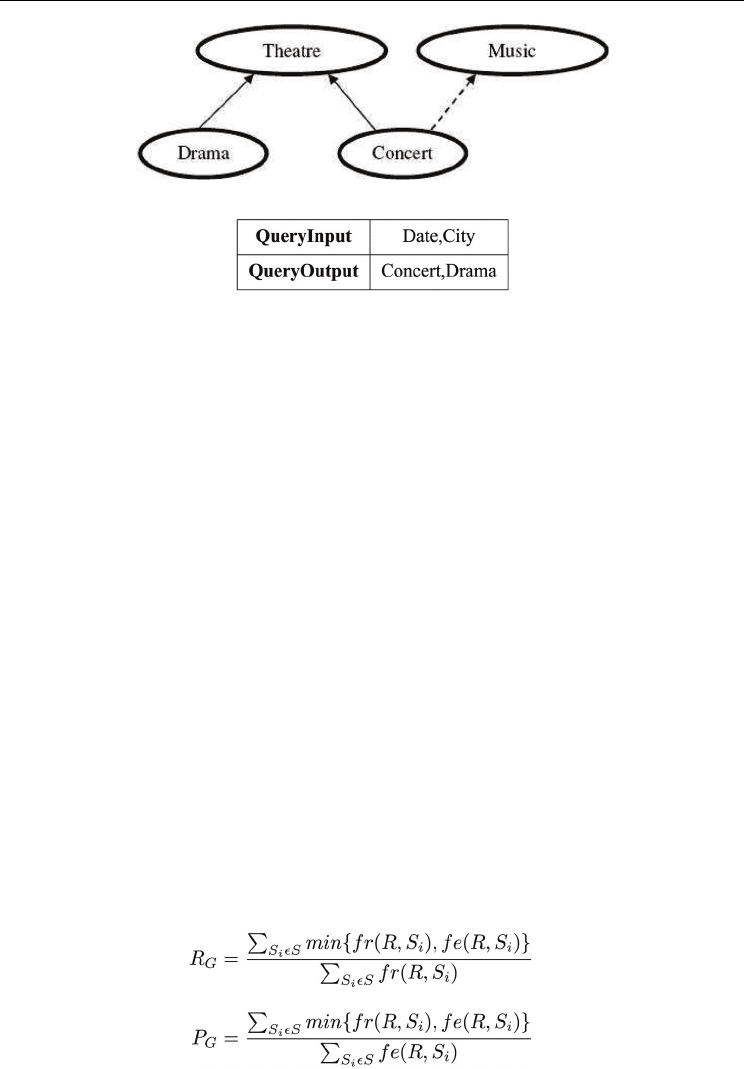Bednorz W. (ed.) Advances in Greedy Algorithms
Подождите немного. Документ загружается.

26
Semantic Matchmaking Algorithms
Umesh Bellur
1
and Harin Vadodaria
1
Department of Computer Science and Engineering, Indian Institute of Technology, Bombay
2
Sybase Software, Pune
India
1. Introduction
The advantages of loose coupling offered by service oriented architectures (SOA) have made
it a popular choice for today’s enterprise systems. The popularity has driven
standardization efforts in the areas of service advertisement and invocation and services
specified using these standards are termed as Web services. A Web service is self containing,
self describing application that can be deployed, published and invoked over the Internet.
The publish-find-bind approach is the fundamental idea behind Service Oriented
Architectures that web services aim to implement. The ultimate vision of SOA is to enable a
client to automatically select an appropriate service from a pool of dynamically discovered
services and invoke it without having any apriori knowledge about the service provider and
the specifics of the service itself. This vision has thrown up various challenges such as -
service discovery based on an abstract query, selection of service from the discovered pool, service
composition, dynamic service binding and invocation, quality of service, negotiation of service
contracts and trust.
Enhancing what has traditionally been sytanctic descriptions of services with semantics is
necessary to resolve most of these issues. Once semantic descriptions are available, one
needs to deal with matchmaking of these descriptions to a query. In the rest of this chapter
we present concepts involved in semantic matchmaking as it applied to web services and a
set of algorithms that solve the semantic matchmaking problem.
1.1 Background concepts
In this section, we present necessary background concepts essential to understand the rest of
the chapter. The chapter centers around Web services although there exist several other
implementation of SOA concepts such as Jini for Java.
1.1.1 Service discovery
Service discovery is the process of evaluating a query for a service and returning a set of
compatible services. WSDL and UDDI are two standards used in service discovery. The
Simple Object Access Protocol (SOAP) is a messaging protocol used to invoke web services
and get back results asynchronously.
• The Web Services Description Language (WSDL) [3] is a language for description of
service and contains operations supported by the service. Each operation is described

Advances in Greedy Algorithms
482
by it’s input and outputs. WSDL description of a service defines XML message format
for communication with the service. A compiler at the client generates stubs based on
the WSDL description for: 1) Marshaling and unmarshaling objects into SOAP
messages. 2) Sending SOAP messages over communication protocol. The application is
then bound with these stubs to invoke the service.
• The Universal Description and Discovery Interface [2] is a registry that contains
information about different services offered by various service providers. This
information is usually output as a WSDL document. UDDI provides mechanisms for:
1) Publishing a service to the registry 2) Searching a required service from the
registry. The state of the art today limits storage in UDDI to Strings and searches are
syntactic in nature as well.
1.1.2 Ontology
Ontology represents knowledge about a particular domain. This knowledge includes
entities in the domain, their property and relationship with each other. Entities in the
ontology are termed Concepts. A well defined syntax is required to unambiguously represent
concepts of a domain. RDF[16] framework is suitable for describing an ontology. Web
Ontology Language (OWL)[17] is developed on the top of RDF and is used for ontology
description. Given below is a part of Entertainment ontology.
1.1.3 OWL-S: semantic markup for web services
Semantic web is not merely a collection of marked up content but includes (software
applications packaged as) services as well. It is essential for a software agent to discover,
compose, invoke and monitor web resources in order to take advantage of a service. OWL-S
[1] (formerly, DAML-S) is a language for describing services which makes this possible. It
uses RDF as basic framework. OWL-S is required to perform following tasks automatically.
• Web Service Discovery: Extract the information from the page in order to find a
required service.
• Web Service Invocation: OWL-S along with the domain ontology specifies the
invocation methods of a Web Service (e.g. necessary inputs, expected outputs).
• Web Services Composition and Interoperation: OWL-S provides declarative way to
specify prerequisite and consequences of a service which helps software agents in
composing different web services.
OWL-S provides Service Profile, Service Model and Service Grounding to represent
Description, Functionality and Access Mechanism respectively.

Semantic Matchmaking Algorithms
483
• Service Profile: Service profile facilitates Service Provider to describe its service. It is up
to the Service Provider how much details are given in the Service Profile. E.g. a Book
selling service may also provide browsing facility but it is not necessary that it is
included in Service Profile. We can categorize the information provided by Service
Profile as:
- Provider’s Information - This may include name of the provider and contact details.
- Functional Description - specifies inputs required, output generated and
conditions to be set at the beginning and change in the real world after service
completes its function. In short, inputs, outputs, preconditions and effects are
described here.
- Profile Attributes - Some parameters that service wants to specify e.g. quality
guarantees, service categorization etc. They are represented by Service Parameter
and Service Category.
• Service Model: It describes service as a process, either atomic or composite: receives
and sends a single message or retains/changes state through a sequence of messages. A
service can give some output and set some condition thus changing real world.
- Inputs and output parameters are expressed as a subclass of the parameter class in
OWL-S.
- Preconditions and effects are modeled as logical formulas or expressions which are
treated as either string literals or XML literals depending on the language used.
The expression class in OWL-S specifies two separate subclasses condition and effect
for precondition and effect respectively.
Often outputs and effects of the service are coupled together with a condition bounding
them. E.g. service for selling software modules may have different results and effects
depending on a failed or succeeded transaction.
Composite processes are more difficult to handle. They have a set of sub processes
associated with a control structure. The control structure will specify the order in which
different sub processes are executed. In case of composite process, client needs to send a
series of messages to get the final result. Different types of control structures are: Sequence,
Split, Split+Join, Any-Order, Choice, If-Then-Else, Iterate, Repeat While and Repeat Until.
Data flow and parameter binding is very critical issue in case of composite process. OWL-S
has adopted Consumer-Pull convention i.e. if p2 requires input which comes from p1, p2 is
responsible for explicitly describing this fact.
Service Grounding: Grounding deals with the realization of services. It provides concrete
details necessary to invoke the service such as message format, transfer protocol etc. OWL-S
uses WSDL standard for Service grounding. WSDL provides a wrapper and can carry OWL-
S message on standard network protocols. WSDL can not capture the semantic of a message
while OWL-S in its own is not capable to deal with the standard transfer protocol. Both
languages overlap at description of message at abstract level. Mapping from OWL-S to
WSDL is done in 3 steps:
- An OWL-S atomic process corresponds to a WSDL operation.
- Inputs and outputs of OWL-S process correspond to input part and output part of
WSDL messages respectively.
- Inputs and output of OWL-S process correspond to WSDL’s abstract type.
An example of OWL-S profile is as follows:

Advances in Greedy Algorithms
484
2. What is semantic matchmaking?
The publish-find-bind architecture targets dynamic service invocation - i.e., the client of the
service invocation has no prior knowledge of the service description and hence cannot link
in pre-compiled stubs. Specification standards such as WSDL and registry standards such as
UDDI facilitate the discovery process that is needed for dynamic invocation. Together UDDI
and WSDL can serve the goal of automatic discovery of web services. However, the
matching mechanism provided by UDDI and WSDL is no better than a simple string
matching in XML. In reality automated service discovery can not be accomplished by mere
string matching. For example, a simple service that takes two integers as input and produces
a float as output could actually perform one of a variety of operations like interest
calculation on a principal and period, average points per game given the total points and
games etc. A simple syntax based matching can produce many false positives since nature of
service is not captured in the service description.
In order to overcome this limitation, concept of semantics has been introduced with OWL-S.
In this approach, functionality of a service is described in terms of inputs, outputs,
preconditions and effects. Input and output terms of the service are expressed as concepts
belonging to a set of ontologies. Use of ontology allows referring to a single concept from
two or more syntactically different terms. Thus, it eliminates the limitations caused by
syntactic difference between terms since matching is now possible on the basis of concepts
of ontologies used to describe input and output terms.
For semantic matchmaking, if we assume that both, advertisement and query are defined in
OWL-S format then an advertisement Advt and query Query match if
• For every input parameter in Advt, there is one input parameter in Query. Let Query
in
and Advt
in
represent the list of input concepts of query and the advertisement
respectively. The service can correctly perform the task if all the input concepts defined
in the advertisement are satisfied by the requester. Hence, matching of inputs exist if
• For every output parameter in Query, there is one output parameter in Advt. Let
Query
out
and Advt
out
represent the list of output concepts of query and the advertisement

Semantic Matchmaking Algorithms
485
respectively. The service can be used by the requester if all the output concepts defined
in the query are satisfied by the advertisement. Hence, matching of outputs exist if
• For every precondition in Advt, there is one precondition in Query. Let Query
precondition
and Advt
precondition
represent the list of preconditions of query and the advertisement
respectively. The service can correctly perform the task if all the preconditions
defined
in the advertisement are satisfied by the requester. Hence, matching of preconditions
exist if
• For every effect in Query, there is one effect in Advt. Let Query
effect
and Advt
effect
represent
the list of effects of query and the advertisement respectively. The service can be used
by the requester if all the effects defined in the query are satisfied by the advertisement.
Hence, matching of effects exist if
2.1 An example
Let us now look at an example of how a request is matched with service advertisements. The
service that is advertised is a car selling service which, when given a Price as input, return
which car can be bought at that price. A strip-down version of advertisement is shown in
Figure 2. As, is clear the input to the service are instances of the concept Price and the output
is instances of the concept Car.
Fig. 1. A fragment of Vehicle Ontology [12]
Shown below is an example request in the same format. The request shows that the service
sought should take as input instances of Price and should generate output as instances of
Sedan.

Advances in Greedy Algorithms
486
Now, in the given example, for service to match with the request we need to match inputs as
well as outputs. In this case, inputs match directly as they both contain the same concept
Price. The outputs also match as Car provided by the service in the given ontology is a super
class of the Sedan which is expected in the request. Hence, this will be considered as a
suitable match although the score(or rank) of this match will vary accordingly with different
semantic matchmaking algorithms.
Fig. 2. Advertisement of a car selling service [12]
Fig. 3. Request for a car selling service service [12]
If we had an advertisement with Sedan as a concept, it must be ranked higher than the above
advertisement as it is closer to the given request. From this example, it is clear, the match
performed is a semantic match. The reason is because the fact that Car is a superclass of
Sedan has been used while matching. In a syntactic matching scenario, this would result in
no match as Car and Sedan are syntactically very different.

Semantic Matchmaking Algorithms
487
Note that in given example service semantics are described by input and output parameters
only. In addition to these parameters, preconditions and effects can also be added to define
restriction over parameter values.
3. Taxonomy of semantic matchmaking algorithms
In this section, we present the qualitative and quantitative aspects on which a semantic
matchmaking algorithm can be evaluated. We then use this to compare and contrast
different efforts in the area.
3.1 Qualitative aspects
Semanticmatching as compared to syntacticmatching As the term semantic matchmaking
suggests, a semantic matchmaking algorithm should consider the meaning of concepts
while performing comparisons between services and requests. It should take into account
the various relations which exist between the concepts in the ontology in the process of
matchmaking.
For example, in the ontology given by 1, when a request contains Sedan, a service with
concept Car should be given more weightage than concept Vehicle as Sedan is closer to Car in
the ontology. Similarly, a service with Sedan should be given an appropriate score(less than
Car) when a request for Car is made by taking into account the fact that Sedan could only
partially satisfy the request. Its important to note that in pure syntactic matching, this kind
of reasoning is not possible as the meaning of the concepts are not considered.
False positives and negatives False positives are returned when a semantic matchmaking
algorithm matches an advertisement to a given request even if it was not relevant.
Analogically, a false negative is the case where a semantic matchmaking algorithm fails to
match a relevant advertisement to the given request. There is a trade off between the
number of false positives and false negatives returned by a matchmaking algorithm. As the
algorithm becomes more flexible, the number of false positives increase and number of false
negatives decrease. Therefore, its necessary to regulate the flexibility of the semantic
matchmaking algorithm so as to have a balanced number of false positives and negatives.
The requesting service should have some control over the flexibility of the algorithm.
Notion of Flexible matching The semantic matchmaking algorithm should promote the
advertisers to be more precise in their description. It can be done by providing a degree of
match for the matched advertisements. The degree of match should be higher for
advertisements which are closer to the request and hence imposing penalty on
advertisements which are very general. If this is not done, then all the advertisers will make
advertisements as general as possible to increase their chances of match rather being specific
about what they actually have.
Consider that AdOp is one of the concepts of the outputs of an advertisement Qop is one of
the concepts of the outputs of a query. Four degrees of matching are:
• Exact: If AdOp is an equivalent concept to QOp, then they are labeled as Exact match.
• Plug in: If QOp is superclass of/subsumes AdOp, then AdOp can be plugged in place of
QOp. Thus, it is marked as Plug in match.
• Subsumes: If AdOp is superclass of/subsumes QOp, then service may fulfill the
requirements of the request since advertisements provides output in some of the
subclasses of the concept defined by QOp. Thus, it is a subsume match.

Advances in Greedy Algorithms
488
• Fail: If no subsumption relation is found between QOp and AdOp, then it is declared as
failure.
Soft constraints Soft constraints are constraints which should be preferably but not
necessarily be satisfied. For example, if we are ordering a DVD from a web-based DVD
store, we could specify that we would prefer to pay by a credit card. A semantic
matchmaking algorithm should be able to take soft constraints into account while
performing matches. Hence, an advertisement which satisfies a soft constraint should be
given better ranking than an advertisement which does not (assuming they satisfy other
constraints with same degree of match).
Preference of concepts The user should be able to specify which concepts are preferred. A
semantic matchmaking algorithm should to take into account the preference of concepts as
specified by the user. For example, if a user needs to book a hotel for his journey, then most
important concepts for him would be the city and date. Other concepts(for e.g. prices) even if
matched would be useless unless it is in the same city as mentioned by the user. Hence its
important that the algorithm gives higher ranking to advertisements which match concepts
of higher preferences.
User defined matching The user should have some control over the matching process. The
algorithm should give the user ability to regulate various aspects such as the flexibility of
the algorithm, the quality or rating which is expected for the service etc. User-defined
matching helps make the matching process more suited to one’s needs.
Heterogeneous ontologies The semantic matchmaking example, we discussed in previous
section assumes that both the service and the request use the same shared ontology for
description. However, in a truly distributed environment where services are autonomous
this assumption may not hold true. Hence, an algorithm must be able to perform semantic
matching across descriptions with heterogeneous ontologies.
Quality-of-Service(QoS) enabled discovery All the aspects we have discussed so far deal
with how closely the advertisement matches functionally with the request. However, non-
functional and QoS properties such as price, performance, throughput, reliability,
availability, trust etc. are equally important while deciding whether a service is satisfactory
for a given request. Hence, a semantic matchmaking algorithm must take into account the
presence of such parameters while matching. User feedback must be taken into account in
this framework to define QoS properties for various services.
3.2 Quantitative measures
Efficiency : As we know that the search has to be made over all possible advertisements for
services. Given the current size of Web, the number of services existing on web and hence
the number of advertisements will be huge. Hence, for the semantic matchmaking process to
scale up to the size of web, the computational complexity of the algorithm should not be
high.
Precision : Precision is defined as the number of ”relevant and retrieved” advertisements
over the number of ”retrieved” advertisements. As the algorithm becomes more flexible in
matching, the number of false positives increase and hence precision decreases. Therefore,
Table 1. Advertisement

Semantic Matchmaking Algorithms
489
Fig. 4. A part of Entertainment Ontology
Table 2. Query
to obtain higher precision the semantic matchmaking algorithm has to be more rigid in
matchmaking.
Recall Recall is defined as the number of ”relevant and retrieved” advertisements over the
number of ”relevant” advertisements. As the algorithm becomes more flexible in matching,
the number of false negatives decrease and hence recall increases. Therefore, to obtain
higher recall the semantic matchmaking algorithm has to be more flexible in matchmaking.
F1 and break-even : As discussed earlier, we need to have regulated amount of flexibility in
the algorithm to balance precision and recall. Since there is a trade-off between precision
and recall, we can use unified measures which will give weightage to both precision and
recall. For example, F1 is defined as the harmonic mean of precision and recall. Hence, when
maximized, it would result in both precision and recall set to acceptable values. Similarly,
break-even is the point where the precision and recall curves meet each other.
Precision and recall are very coarse-grained measures as they categorise a document into
two categories :- relevant or irrelevant. Especially, in the context of semantic matchmaking
where the degree of match between query and advertisement comprises of many levels,
such coarse-grained measures are not the best indicators of performance of matchmaking.
We need fine-grained evaluative measures which can distinguish between documents
matching with various degrees of match. [16] proposes a method based on fuzzy logic
which provides fuzzy equivalents of precision and recall as measures to quantify
performance of matchmaking.
These equivalents are computed in terms of two membership functions, one defined by the
semantic matchmaking engine and one by the domain experts. The two membership
functions are fe : Q×S → [0, 1] , and fr : Q×S → [0, 1]. fe is delivered by the algorithm and fr is
calculated by the feedback of domain experts. These functions are computed using
fuzzification of the degree of match performed between the advertisement and the request.
The fuzzy logic equivalents of Recall(R
G
) and Precision(P
G
) are defined in Equations 1 and 2.
(1)
(2)

Advances in Greedy Algorithms
490
Since, theses measures are fuzzy, they take into account the values for all the advertisements
and not only those documents which are relevant or returned.
4. A survey of matchmaking algorithms
In this section we take a in-depth look into existing semantic matchmaking algorithms.
4.1 Greedy approach
This algorithm was proposed by [12]. It is based on semantic matchmaking based on input
and output terms.
Algorithm presented in [12] is a greedy approach for matchmaking. Algorithm tries to
match every output concept of Query with one of the concepts of Advertisement. It starts
from all output concepts (call it candidate list) of Query and removes a concept from
candidate list as soon as it is matched with a concept from Advertisement with degree of
matching > Fail.
[12] uses following scheme for degrees of matching.
• Exact: If AdOp is an equivalent concept to QOp, then they are labeled as Exact match. If
QOp is a subclass of AdOp, then match is considered Exact under the assumption that
provider agrees to provide output in every possible subclasses of AdOp.
• Plug in: If AdOp subsumes QOp, then AdOp can be plugged in place of QOp. Here
also, it is assumed that provider agrees to provide output in some of the subclasses of
AdOp.
• Subsumes: If QOp subsumes AdOp, then service may fulfill the requirements of the
request since advertisements provides output in some of the subclasses of the concept
defined by QOp.
• Fail: If no subsumption relation is found between QOp and AdOp, then it is declared as
failure.
4.1.1 Discussion
Scheme for Degrees of matching assumes that service provider agrees to provide output in
every possible subclass of the output concept. Also, Algorithm is dependent on the order in
which concepts are defined in the Query. Consider following example.
As depicted in figure 4, Drama and Concert are subclass of the concept Theatre. Concert is
also a sub-concept of Music via inferred relationship.
Output concept list for Query and Advt are:
• Advt
output
= Theatre, Music
• Query
output
= Concert, Drama
At first, algorithm will try to match Concert with all concepts of candidate list of Advt
output
.
We have,
• Theatre is superclass of Concert ⇒ Exact match
• Music subsumes Concert ⇒Plugin match
Since the algorithm uses greedy approach, it will match Concert with Theatre and removes
both from respective lists. Now there is only one concept in Advt
output
and,
Match(Drama, Music) = Fail
Thus, the algorithm will return Fail match for Query and Advt. In reality, we can have
following matching.
